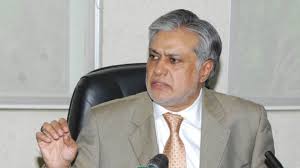The Prime Minister’s economic team have informed Pakistan Today that Finance Minister Ishaq Dar has been pressing the country’s finance managers and State Bank of Pakistan (SBP) to continue to manipulate the foreign currency market in order to portray a false positive image of the country’s economy.
The sources claim that the minister is pursuing a policy of artificial overvaluation of the Pakistani rupee despite advice to the contrary given by SBP, Planning Commission and the Ministry of Commerce.
“The observations were raised during an Economic Coordination Committee (ECC) meeting but were overruled”, a source in the Planning Commission told this scribe requesting anonymity.
Another source in the Ministry of Finance, confirmed the overvaluation, stating that the measure had been adopted to get political mileage in favour of the PML-N government.
When approached for comments, Chief Spokesperson of Ministry Of Finance, Dr. Shujaat refused to contradict or confirm the overvaluation of exchange rate.
“I would offer no comments as you have no evidence. This looks to be a mere statement,” the chief spokesman said.
It may be recalled that last year, the International Monetary Fund (IMF) also warned against exchange rate manipulation, advising Pakistan that currency overvaluation was causing a “great set-back” to the country’s exports.
“Pakistan’s rupee, Asia’s best performing currency over the past two years, is overvalued between 5 per cent and 20 per cent, the International Monetary Fund estimated on Friday (Nov. 6, 2015),” Bloomberg said in a report.
“If the exchange rate is going to depreciate by that amount, then that would be in line with fundamentals,” the report said, quoting Harald Finger, the IMF’s Pakistan mission chief. “The rupee has been relatively stable against the U.S. dollar over the past two or three years despite the greenback’s appreciation against other currencies,” he said – over the past two years, the rupee has gained 1.7 per cent to 105.5 a dollar (as on Nov.6, 2015), the only one to strengthen among 12 Asian currencies tracked by Bloomberg.
The report further said the rupee erased earlier losses after Prime Minister Nawaz Sharif in 2013 won a $6.4 billion loan from the IMF to prop up foreign reserves and stave off a balance-of-payments crisis. However, the PM has not been able to attract more stable flows and critics say the dollar stockpile masks risks that could push Pakistan toward more external funding, Bloomberg said in its report.
In response to the question of overvalued exchange rate, Sakib Sherani, former Economic Advisor, said “yes, our exchange rate is undoubtedly overvalued and it is being endorsed by the IMF”. He also explained that one of the models suggest that it is overvalued by 5 to 6 per cent, while IMF’s model estimates it to be overvalued up to 20 per cent. “However, some of the monetary experts think, it is not that much overvalued”, added Sherani.
Pakistan Institute of Development Economic’s Research Economist, Mohammad Ali Kemal said, “Overvaluation of the exchange rate is the worst we can offer our exporters. Though it is just done to control inflation and keep the debt at a lower level.” It is rhetorically popular that a dollar change in exchange rate increase external debt by Rs 63 billion. Therefore, if 20 per cent overvalued exchange rate is corrected, it will increase the value of our external by Rs 20 per dollar. This implies that our external debt will increase by Rs 1260 billion, which will hurt politically.
Pakistan’s current account deficit has remained negative Since April-June quarter of 2015 and stood at $808 million at the end of FY2016, according to Tradingeconomics.com. Quarterly current account balance has a positive CAB bars. But, due to increase in remittances there are lesser import bills and exports are increasing.
Albeit the oil prices in the International Market have declined as compared to the last couple of years, it is quite predictable that this year’s current account deficit will be negative. On the other hand, trade deficit since last two years has been increasing and keeping in mind the overall decline in global income, Brexit and overvaluation of exchange rate, it will surely increase this year as well.
Conversely, Kemal also explained that depreciation of the Rupee may increase exports and industrial activity which may offset the impact of increase in debt. “But we believe that future is unknown and that is what they are afraid of”, stated Kemal.
“Exports in Pakistan shrank 4.1 per cent year-on-year to Rs 154,955 million in July of 2016, hitting the lowest level since November 2011”, according to Pakistan Bureau of Statistics.
Answering the question regarding the government’s actions for reduction in trade balance, Sherani stated that “government is doing absolutely nothing in this respect”. He further added that anti-export policies need to be corrected. Nevertheless, Sherani appreciated the government’s initiative of introducing Re-gasified Liquefied Natural Gas (RLNG) and predicted that “it will provide a boost in the next 2-3 months”.
According to Kemal, “the only way we can increase exports to structure our economy in a better way is by having new agreements of trade, setting the par value of exchange rate, decreasing the cost of doing businesses for both exporters and local traders, and moving towards value addition and Hi Tech industrialization”. Moreover, he was of the view that it is also necessary to stop giving protection to all those industries who are still inefficient after so many years of protection. “Identify new industries, protect them for a few years and plan accordingly by strict monitoring procedures,” he added.




